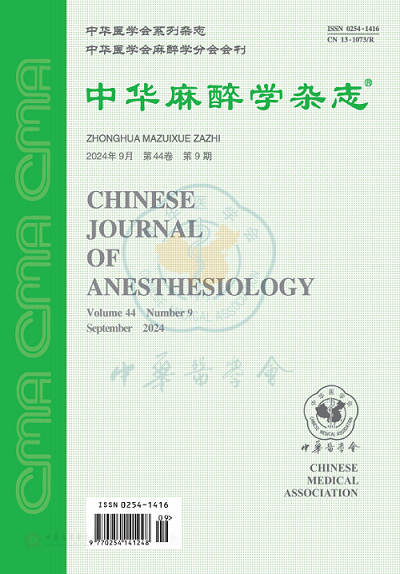Pediatric anesthesia-related specification during coronavirus disease 2019 epidemic
Weifeng Yu, Yuguang Huang, L. Yang
{"title":"Pediatric anesthesia-related specification during coronavirus disease 2019 epidemic","authors":"Weifeng Yu, Yuguang Huang, L. Yang","doi":"10.3760/CMA.J.CN131073.20200219.00306","DOIUrl":null,"url":null,"abstract":"Coronavirus disease 2019 is highly infectious and generally susceptible to all human beings Pediatric patients, as a special group which is prone to various respiratory infectious diseases, need more people to nurse and care and may cause a higher risk of cross-infection Therefore, greater attention should be paid to this group During the prevention and control of coronavirus disease 2019, it is an urgency to ensure the safety of children and medical staff, avoid cross-infection, reduce anesthesia-related complications, and accelerate the rehabilitation of pediatric patients The article introduces the following aspects based on the problem mentioned above: (1) perioperative treatment of surgery, involving preoperative consultation and assessment, necessity of surgery, arrangement of operating room, precautions during surgery, protection of children and medical staff, and the transportation route planning;(2) anesthesia process, including pick-up of the pediatric patient, preoperative sedation, choice of anesthesia method, anesthesia induction, identification and management of difficult airways, intraoperative management, as well as problems related to the extubation;(3) the disinfection of the ground, air and medical equipment after surgery, and registration and follow-up of the children;(4) protection and preparation of emergency tracheal intubation, selection and performance of intubation, precautions in intubation and judgement after intubation outside the operating room;(5) protection and preparation of central vein catheterization, selection of the catheter, anesthesia management of the central vein catheterization and relevant precautions;(6) protection of medical staff, sedation program and sedation procedure during the comfort treatment in outpatient sedation center;(7) problems of family signature of the in-hospital treatment for pediatric patients during special epidemic period © 2020 Chinese Medical Association","PeriodicalId":10053,"journal":{"name":"中华麻醉学杂志","volume":"40 1","pages":"281-286"},"PeriodicalIF":0.0000,"publicationDate":"2020-03-20","publicationTypes":"Journal Article","fieldsOfStudy":null,"isOpenAccess":false,"openAccessPdf":"","citationCount":"0","resultStr":null,"platform":"Semanticscholar","paperid":null,"PeriodicalName":"中华麻醉学杂志","FirstCategoryId":"3","ListUrlMain":"https://doi.org/10.3760/CMA.J.CN131073.20200219.00306","RegionNum":0,"RegionCategory":null,"ArticlePicture":[],"TitleCN":null,"AbstractTextCN":null,"PMCID":null,"EPubDate":"","PubModel":"","JCR":"Q4","JCRName":"Medicine","Score":null,"Total":0}
引用次数: 0
Abstract
Coronavirus disease 2019 is highly infectious and generally susceptible to all human beings Pediatric patients, as a special group which is prone to various respiratory infectious diseases, need more people to nurse and care and may cause a higher risk of cross-infection Therefore, greater attention should be paid to this group During the prevention and control of coronavirus disease 2019, it is an urgency to ensure the safety of children and medical staff, avoid cross-infection, reduce anesthesia-related complications, and accelerate the rehabilitation of pediatric patients The article introduces the following aspects based on the problem mentioned above: (1) perioperative treatment of surgery, involving preoperative consultation and assessment, necessity of surgery, arrangement of operating room, precautions during surgery, protection of children and medical staff, and the transportation route planning;(2) anesthesia process, including pick-up of the pediatric patient, preoperative sedation, choice of anesthesia method, anesthesia induction, identification and management of difficult airways, intraoperative management, as well as problems related to the extubation;(3) the disinfection of the ground, air and medical equipment after surgery, and registration and follow-up of the children;(4) protection and preparation of emergency tracheal intubation, selection and performance of intubation, precautions in intubation and judgement after intubation outside the operating room;(5) protection and preparation of central vein catheterization, selection of the catheter, anesthesia management of the central vein catheterization and relevant precautions;(6) protection of medical staff, sedation program and sedation procedure during the comfort treatment in outpatient sedation center;(7) problems of family signature of the in-hospital treatment for pediatric patients during special epidemic period © 2020 Chinese Medical Association
2019冠状病毒病流行期间小儿麻醉相关规范
小儿患者作为易患各种呼吸道传染病的特殊群体,需要更多的人护理和护理,并可能造成较高的交叉感染风险,因此,在2019冠状病毒病的防控过程中,迫切需要确保儿童和医护人员的安全,避免交叉感染。减少麻醉相关并发症,加快小儿患者康复。针对上述问题,本文介绍了以下几个方面:(1)手术围术期处理,包括术前会诊评估、手术必要性、手术室布置、术中注意事项、患儿及医护人员保护、运输路线规划等;(2)麻醉过程,包括儿科患者的接送、术前镇静、麻醉方式的选择、麻醉诱导、困难气道的识别与处理、术中管理等;(3)术后地面、空气及医疗设备的消毒,患儿的登记与随访;(4)急诊气管插管的保护与准备,插管的选择与操作,插管时的注意事项,手术室外插管后的判断;(5)中心静脉置管的保护与准备,导管的选择,中心静脉置管麻醉管理及注意事项;(6)门诊镇静中心舒适治疗期间医护人员的保护、镇静方案及镇静程序;(7)特殊疫情期间儿科患者住院治疗家属签名问题©2020中华医学会
本文章由计算机程序翻译,如有差异,请以英文原文为准。


